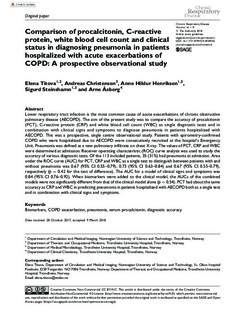| dc.contributor.author | Titova, Elena | |
| dc.contributor.author | Christensen, Andreas | |
| dc.contributor.author | Henriksen, Anne Hildur | |
| dc.contributor.author | Steinshamn, Sigurd Loe | |
| dc.contributor.author | Åsberg, Arne | |
| dc.date.accessioned | 2019-09-18T06:23:37Z | |
| dc.date.available | 2019-09-18T06:23:37Z | |
| dc.date.created | 2019-03-05T12:35:49Z | |
| dc.date.issued | 2018 | |
| dc.identifier.citation | Chronic Respiratory Disease. 2018, 16 1-9. | nb_NO |
| dc.identifier.issn | 1479-9723 | |
| dc.identifier.uri | http://hdl.handle.net/11250/2617318 | |
| dc.description.abstract | Lower respiratory tract infection is the most common cause of acute exacerbations of chronic obstructive pulmonary disease (AECOPD). The aim of the present study was to compare the accuracy of procalcitonin (PCT), C-reactive protein (CRP) and white blood cell count (WBC) as single diagnostic tests and in combination with clinical signs and symptoms to diagnose pneumonia in patients hospitalized with AECOPD. This was a prospective, single centre observational study. Patients with spirometry-confirmed COPD who were hospitalized due to AECOPD were consecutively recruited at the hospital’s Emergency Unit. Pneumonia was defined as a new pulmonary infiltrate on chest X-ray. The values of PCT, CRP and WBC were determined at admission. Receiver operating characteristic (ROC) curve analysis was used to study the accuracy of various diagnostic tests. Of the 113 included patients, 35 (31%) had pneumonia at admission. Area under the ROC curve (AUC) for PCT, CRP and WBC as a single test to distinguish between patients with and without pneumonia was 0.67 (95% CI 0.55–0.79), 0.73 (95% CI 0.63–0.84) and 0.67 (95% CI 0.55–0.79), respectively (p = 0.42 for the test of difference). The AUC for a model of clinical signs and symptoms was 0.84 (95% CI 0.76–0.92). When biomarkers were added to the clinical model, the AUCs of the combined models were not significantly different from that of the clinical model alone (p = 0.54). PCT had about the same accuracy as CRP and WBC in predicting pneumonia in patients hospitalized with AECOPD both as a single test and in combination with clinical signs and symptoms. | nb_NO |
| dc.language.iso | eng | nb_NO |
| dc.publisher | Sage Publications | nb_NO |
| dc.rights | Navngivelse-Ikkekommersiell 4.0 Internasjonal | * |
| dc.rights.uri | http://creativecommons.org/licenses/by-nc/4.0/deed.no | * |
| dc.title | Comparison of procalcitonin, C-reactive protein, white blood cell count and clinical status in diagnosing pneumonia in patients hospitalized with acute exacerbations of COPD: A prospective observational study | nb_NO |
| dc.type | Journal article | nb_NO |
| dc.type | Peer reviewed | nb_NO |
| dc.description.version | publishedVersion | nb_NO |
| dc.source.pagenumber | 1-9 | nb_NO |
| dc.source.volume | 16 | nb_NO |
| dc.source.journal | Chronic Respiratory Disease | nb_NO |
| dc.identifier.doi | 10.1177/1479972318769762 | |
| dc.identifier.cristin | 1682359 | |
| dc.description.localcode | Open Access. This article is available under the Creative Commons CC-BY-NC license and permits non-commercial use, distribution and reproduction in any medium, provided the original work is properly cited. | nb_NO |
| cristin.unitcode | 1920,8,0,0 | |
| cristin.unitcode | 194,65,25,0 | |
| cristin.unitcode | 1920,14,0,0 | |
| cristin.unitname | Klinikk for lunge og arbeidsmedisin | |
| cristin.unitname | Institutt for sirkulasjon og bildediagnostikk | |
| cristin.unitname | Laboratoriemedisinsk klinikk | |
| cristin.ispublished | true | |
| cristin.fulltext | original | |
| cristin.qualitycode | 1 | |

